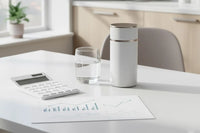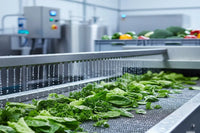If you’ve ever walked through a Ready-to-Eat (RTE) zone before opening hours, you know the pressure.
This isn’t a “wipe and go” environment. It’s the final barrier between your product and the public.
One missed pathogen, one positive swab, and everything downstream becomes a liability:
- Entire batches placed on hold
- Emergency ATP testing
- Third-party audits triggered
- Brand trust eroded
- Recalls launched with one lab report
RTE zones are sacred ground. They demand sanitizers that are unforgiving to pathogens—but gentle to food, air, workers, and surfaces.
And this is where hypochlorous acid (HOCl) has become the go-to weapon for next-gen sanitation managers.
Because HOCl is the first and only disinfectant powerful enough for Listeria control—yet safe enough to fog directly into occupied RTE environments.
Let’s explore why HOCl is the perfect fit for RTE sanitation—and how facilities are cutting PPE, rinse cycles, and audit stress in one move.
What Makes RTE Zones So Challenging?
Ready-to-eat areas operate under stricter rules than general processing areas because:
- There is no kill step after sanitation
- Products are packaged post-sanitization
- The environment must stay low-microbial, low-residue, and low-disruption
- Recontamination risk is highest from tools, gloves, drains, belts, fog, and air
- Swab testing is more frequent and more aggressive—especially for Listeria monocytogenes
That’s why most plants still rely on:
- Bleach (harsh and requires rinse)
- Quats (leave sticky residue, must be rinsed, potential for resistance)
- Peracetic acid (PAA) (corrosive, smells harsh, can damage lungs)
- Ozone or UV systems (costly, non-portable, non-surface-compatible)
None of these are ideal. Most require:
- Full PPE
- Emptying the room
- Delays during application
- Post-rinse cycles
- Re-entry waiting periods
HOCl removes all of this friction—while achieving the same or better pathogen kill levels.
HOCl: The RTE-Ready Molecule
Hypochlorous acid (HOCl) is a powerful oxidizer created naturally by the human immune system.
It can now be generated on-site using just salt, water, and electricity, thanks to EcoloxTech’s commercial systems.
What makes HOCl ideal for RTE zones?
✅ 100% food-safe
✅ No rinse required
✅ No PPE needed
✅ Can be fogged into air, onto surfaces, or directly on gloves, tools, and conveyors
✅ Leaves no residue, smell, or chemical trace
✅ Kills Listeria, Salmonella, E. coli, Norovirus, and more in seconds
And because it degrades into water, it doesn’t accumulate or create biofilms.
Real-Time Kill. Zero Disruption.
With HOCl, you can:
- Fog the entire RTE room while operators are working
- Spray high-touch zones (scales, sealers, belts) between runs
- Disinfect gloved hands without alcohol or quats
- Dip trays, bins, and tools in HOCl—then return directly to production
Skip the rinse. Skip the gloves. Skip the waiting.
Every minute saved = more production, less stress, and better compliance scores.
The Listeria Threat—and HOCl’s Response
Listeria monocytogenes is the ultimate RTE zone pathogen.
It thrives in cool, damp zones. It forms biofilms that resist traditional cleaning. And it’s often spread by:
- Floor drains
- Underside of tables
- Belt crevices
- Gloved hands
- Cutting boards
- Slicers and packaging tools
HOCl penetrates these biofilms and oxidizes Listeria cells from the inside out—with zero resistance development and no impact on equipment.
Studies show that HOCl at concentrations as low as 100 ppm can eliminate 99.999% of Listeria within 30 seconds on:
- Stainless steel
- Plastic belts
- Poly cutting boards
- PPE
- Airborne particles during fogging
What Facilities Are Experiencing
🧀 Cheese Packaging Plant, Wisconsin
Problem: Routine Listeria alerts in RTE zones. Sanitation took 3+ hours including rinse cycles.
Solution: Replaced quat foggers with HOCl fogging and surface sprays.
Result:
- Pathogen alerts dropped to zero
- Swab results improved
- Sanitation cycle cut by 41 minutes
- Reduced water use by 29%
🥪 RTE Sandwich Facility, Ohio
Problem: PPE non-compliance during quick sanitation between runs. Frequent staff complaints about fogging fumes.
Solution: Installed mobile HOCl foggers for safe in-room sanitizing.
Result:
- No more PPE enforcement needed
- Zero downtime for fogging
- Production lines stayed clean without stop/start delays
- Passed SQF audit with highest sanitation score in company history
RTE + HOCl = Compliance Harmony
HOCl is approved by:
✅ EPA List K (food contact surface disinfectants)
✅ FDA GRAS (direct food contact permitted)
✅ NSF D2 (no-rinse food safety certified)
✅ USDA Organic compliant
✅ Acceptable for BRCGS, GFSI, and SQF audits
It integrates seamlessly into your:
- HACCP plans
- SSOPs
- Swab sampling programs
- Allergen zones
- Non-contact high-risk environments
Final Word: Sanitize Smarter, Not Harder
RTE sanitation doesn’t need to be painful.
You don’t need to fog dangerous chemicals.
You don’t need to waste time rinsing.
You don’t need to slow down or suit up.
HOCl gives you full-spectrum kill power—with none of the legacy drawbacks.
It’s the only molecule that aligns with:
- Audit logic
- Worker safety
- Production speed
- Pathogen resistance
- Equipment protection
- Compliance simplicity
If your RTE zone is still running on 1990s chemistry, it’s time to evolve.
Take the Next Step
See how leading facilities are upgrading to HOCl-based sanitation for safer, faster, and fully compliant RTE operations.





